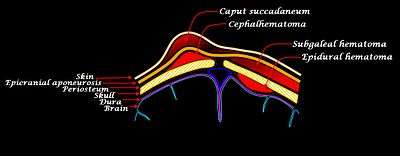Subgaleal hemorrhage
Subgaleal hemorrhage or hematoma is bleeding in the potential space between the skull periosteum and the scalp galea aponeurosis.
| Subgaleal hemorrhage | |
|---|---|
 | |
| Newborn Scalp bleeds | |
| Specialty | Pediatrics |
Symptoms
The diagnosis is generally clinical, with a fluctuant boggy mass developing over the scalp (especially over the occiput) with superficial skin bruising. The swelling develops gradually 12–72 hours after delivery, although it may be noted immediately after delivery in severe cases. Subgaleal hematoma growth is insidious, as it spreads across the whole calvaria and may not be recognized for hours to days. If enough blood accumulates, a visible fluid wave may be seen. Patients may develop periorbital ecchymosis ("raccoon eyes").
Patients with subgaleal hematoma may present with hemorrhagic shock given the volume of blood that can be lost into the potential space between the skull periosteum and the scalp galea aponeurosis, which has been found to be as high as 20-40% of the neonatal blood volume in some studies.[1] The swelling may obscure the fontanel and cross cranial suture lines, (distinguishing it from cephalohematoma).
Patients with subgaleal hemorrhage may also have significant hyperbilirubinemia due to resorption of hemolyzed blood. Laboratory studies may demonstrate reduced hemoglobin and hematocrit due to blood loss into the subgaleal space, and coagulation studies may reflect an underlying coagulopathy. Mortality has been reported to occur in 12-14% of cases, generally as a consequence of massive blood loss presenting with shock, often in the setting of uncorrected coagulopathy. However, with early identification and prompt treatment, the prognosis is good, and there are usually no long-term consequences. [2]
Causes
The majority of neonatal cases (90%) result from applying a vacuum to the head at delivery (ventouse-assisted delivery). The vacuum assist ruptures the emissary veins (i.e., connections between dural sinus and scalp veins) leading to accumulation of blood under the aponeurosis of the scalp muscle and superficial to the periosteum.[3]
Additionally, subgaleal hematoma has a high frequency of occurrence of associated head trauma (40%), such as intracranial hemorrhage or skull fracture. The occurrence of these features does not correlate significantly with the severity of subgaleal hemorrhage.
Diagnosis
Subgaleal hemorrhages may cause seizures but cephalohematoma and caput succedaneum will not cause seizure.
Management
Management consists of vigilant observation over days to detect progression and, if required, of management of complications (e.g., hemorrhagic shock, unconjugated hyperbilirubinemia and jaundice from hemolyzed red blood cells). The subgaleal space is capable of holding up to 40% of a newborn baby's blood and can therefore result in acute shock and death. Fluid bolus may be required if blood loss is significant and patient becomes tachycardic. Transfusion and phototherapy may be necessary. Investigation for coagulopathy may be indicated.
See also
References
- Ronald S. Gibbs; David N. Danforth; Beth Y Karlan; Arthur F Haney (2008). Danforth's obstetrics and gynecology. Lippincott Williams & Wilkins. p. 470. ISBN 978-0-7817-6937-2. Retrieved 12 April 2010.
- Kilani, R.A. (2006). "Neonatal subgaleal hematoma: presentation and outcome - Radiological findings and factors associated with mortality". American Journal of Perinatology. Retrieved 28 June 2019.
- AAP Textbook of Pediatrics